Late last week the Canadian Hockey League did what it had been ordered and provided finances of 40 teams to an
Kind of.
The CHL was ordered to do so as part of a lawsuit based around the argument, basically, that junior hockey teams are a successful business that make lots of money on the backs of unpaid labour.
Those filing the lawsuit want player paid accordingly.
The financial report supplied to the
That financial report was prepared by the accounting firm KPMG on behalf of the CHL. It was also done on financial statements supplied to KPMG by member teams. Not a thorough audit of the team's actual books themselves.
Those two elements alone could be of concern to some and those suing the CHL have already pointed out the financials provided were selective.
The report looked at supplied financials for the past five years.
Teams were not identified, but some educated guessing allows you to figure out which some of the teams were, or at least narrow it down.
When it comes to the Ontario Hockey League, the report says that 11 teams had an average annual net loss over the five year period of $114,000. The nine in the black averaged $175,000 of profit.
But that profitable group includes the league's richest team, identified as "Team 12" in the report, which it's safe to assume is the London Knights. Take them out of the equation (the report says they made $2.9 million one recent year) and the profitable teams average net income is $18,000.
It is interesting to note that the OHL paid out between $1.6 million and $2.9 million each of the last five years in scholarships to former players. The league pays those scholarships, then invoices each team accordingly.
The CHL's report on 40 teams showed what owners continue to argue: that many major junior teams don't make money and that most of those that do don't make much.
It would also support that hypothesis that paying players would create significant financial hardship for many major junior teams.
The report for the CHL was prepared by Dr. Norm O'Reilly.
"Dr. O’Reilly also found that the implementation of a minimum wage policy, in addition to the current benefit package, would put significant financial pressure on many of the 42 WHL and OHL member clubs, such that many would have to consider: (i) Cutting operating expenses and player benefits to offset the additional costs; (ii) Invest additional resources to maintain current operations and support the minimum wage policy; (iii) Ceasing to operate," said the CHL.
Of course finances can be a pretty complex thing. One would assume that if those filing the lawsuit were to go over the finances of those teams, they may come to a different conclusion.
The report done was based on information supplied to them by the member teams. There may be other factors to consider that were not supplied or considered.
But if this argument does indeed come down to numbers, as opposed to a philosophical argument about the legal status of players as employees that should be treated as such, it would appear the CHL has won the first battle.
The numbers refute what the claimant is arguing.
Who wins the war remains to be seen.
